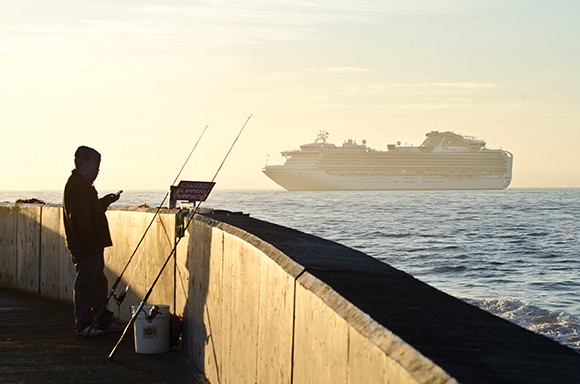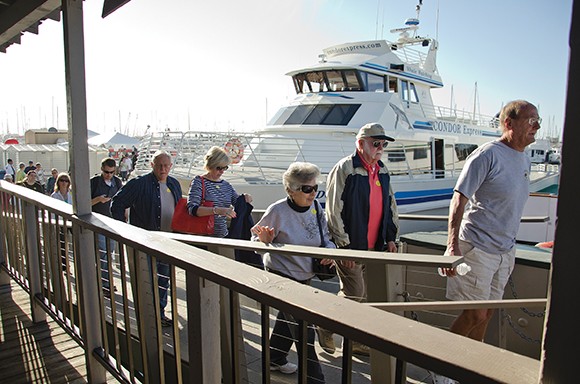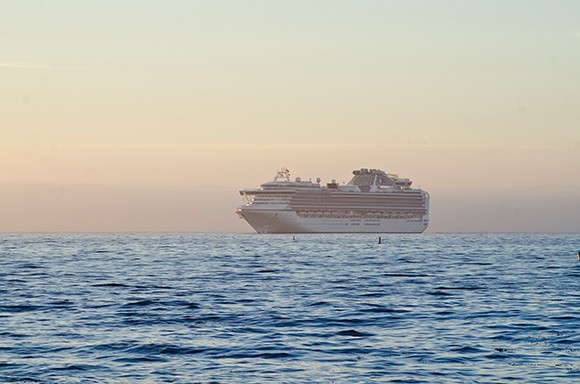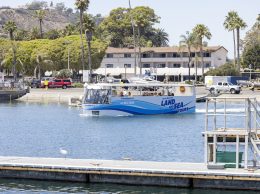Cruise control? Thirty ships slated to call on Santa Barbara in 2014
IN THIS ARTICLE
- South Coast Topic
- Christine De La Cruz Author
By Christine De La Cruz Friday, January 31st, 2014

The Sapphire Princess cruise ship was anchored off the coast of Santa Barbara on Jan. 29. Cruises brought in $2.4 million to the city’s economy last year, according to a recent study. (Alex Drysdale / Business Times photo)
When 30 cruise ships float into Santa Barbara’s harbor this year, several will have poor-to-failing environmental grades. And all the ships will carry passengers that, on average, spend about a quarter of what day-trippers and overnight tourists do.
Twenty-one cruise ships carrying 50,000 passengers visited the city last year, more than double the number in 2012, according to a survey released by Visit Santa Barbara. That number is expected to rise 50 percent this year, though the port calls remain tentative.
Tourism officials are eager to build on the $2.4 million in economic activity that the ships brought in last year. But activists in other cities that have become cruise-line darlings warn of feeling overrun. And environmental groups are keeping a close watch on the massive vessels, which generate an average of 21,000 gallons of sewage each day, according to federal regulatory estimates.
“The cruise ship industry has proven vital to the Santa Barbara South Coast economy,” Visit Santa Barbara President and CEO Kathy Janega-Dykes said in a statement. “Cruise ships come during non-peak travel seasons — a time that is crucial to economic growth within our industry.”
Active recruitment
It’s no coincidence that cruise ships have gone from a rarity to commonplace in just a few years in Santa Barbara. City officials and business leaders teamed up to bolster the economy during the recession and plug holes in the seasonal tourist calendar.
The city’s beginnings as a port of call started in 2002. In the wake of the Sept. 11, 2001, terrorist attacks, Homeland Security required that all ports interested in hosting cruise ships undergo a strict application process for security purposes, and Santa Barbara signed on, according to Brian Slagle, administrative analyst for the Santa Barbara Waterfront District.
But the city didn’t start actively recruiting cruise ships until 2010, in the midst of the economic downturn. Visit Santa Barbara partnered with the Waterfront Department, Santa Barbara Downtown Organization, the Santa Barbara Region Chamber of Commerce and the Metropolitan Transit District to develop a strategy to attract more cruise ships. “There were a lot of folks calling for us to reach out and encourage the cruise ship industry to have more stops here in Santa Barbara,” Ken Oplinger, president and CEO of the Chamber of Commerce, told the Business Times.
Prior to 2011, only one or two cruise ships visited each year, with the exception of 2004 and 2009, which had four and three cruise-ship visits, respectively.
The city itself has benefited, generating $280,000 from passenger fees and sales tax last year. Restaurants and retail businesses swept up the largest share of total passenger spending, taking in 30.5 percent and 29.2 percent, respectively. The numbers are from the Cruise Ship Passenger Survey and Economic Impact Study completed by Destination Analysts for Visit Santa Barbara.
The dollar figures are in line with the activities passengers said they participated in most: 65.7 percent shopped, 64.9 percent went sightseeing and 42.7 percent dined, according to the report. The study is based on more than 800 surveys from September and October, when 11 cruise ships and 26,136 passengers visited the city. The results were annualized across the 2013 calendar year.

Passengers disembark from the Sapphire Princess, a cruise ship owned by Princess Cruises, in Santa Barbara on Jan. 29. Twenty-one cruise ships carrying 50,000 passengers called on the city last year. That number is expected to increase to 30 ships this year. (Alex Drysdale / Business Times photo)
Cruise ship passengers spent an average $44 per person during their visit. That is 28 percent of the average $157 spent per day by day-trippers and hotel guests, according to a visitor survey released in October.
Noncruise visitors also generated $45.8 million in tax revenue for the South Coast last year. But Janega-Dykes noted that cruise passengers have extremely short visits. “It is important to consider that passengers typically are onshore an average of 5-6 hours,” she said in an email to the Business Times.
Most ships visiting Santa Barbara carry roughly 2,500 passengers and about 1,100 crew members, with an estimated 80 percent disembarking. City and tourism officials said cruise visits are scheduled to complement, not interfere with, other tourists. “Cruise ship passengers come during the off-season and over half of the stops in January-May 2014 are mid-week, which does not affect our high-season weekend visitors,” Janega-Dykes said.
There is also the opportunity to bring in an additional $6.3 million in direct visitor spending from cruise-goers who return to Santa Barbara on their own, the passenger survey said. Almost 54 percent of passengers surveyed said they are likely to make a return trip to Santa Barbara in the next year or two. “As we speak to the hotel owners, many of them are seeing more and more of their guests saying they came on a cruise and decided they wanted to come back and spend more time here,” Oplinger said.
A case study in Charleston
While cruise ships can bring millions of dollars into tourist towns, they can also have tremendous drawbacks. One destination that has developed a love-hate relationship with the cruise industry is the maritime city of Charleston, S.C.
The East Coast city, now a home port for Carnival Cruise Lines, is planning to expand and modernize its passenger terminal in the heart of downtown. Lawsuits have been filed and residents are worried about air quality, property values and overcrowding, said Carrie Agnew, executive director of Charleston Communities for Cruise Control. “Tourism is important,” she told the Business Times, “but you can tip the scales. And we think they already have.”
She said with expansion comes the need for legally binding standards and regulations. Currently, operations for the passenger terminal follow voluntary guidelines agreed to by the city of Charleston and the South Carolina Ports Authority. “There are definite … reasons to want to have as many standards or regulations or controls in place that you can enforce,” Agnew said. “You don’t want to get overrun, because it’s hard to turn the clock back.”
Environmental watchdogs
In Santa Barbara, cruise ship captains are required to sign an environmental declaration agreeing not to dump waste within 12 miles of the coast — stricter than the three-mile no-dumping zone mandated under state law.
But compliance is not legally enforceable. “It’s voluntary, and that’s one of the reasons we thought it was important to monitor,” said Ben Pitterle, watershed and marine program director at Santa Barbara Channelkeeper, which works to enforce the provisions. “There have been other similar voluntary agreements that have been violated or breached.”
There have been no mishaps in Santa Barbara to date, but Channelkeeper is taking preventive measures, he said. “The industry has earned over the years kind of a bad rap,” Pitterle told the Business Times. “We’re doing what we can to deter anything from happening just by being present and letting them know someone is watching.”
Some of the ships coming into the harbor have been given low marks by Friends of the Earth on its 2013 Cruise Report Card. Rating sewage treatment, air pollution and water quality, the environmental organization gave an overall F grade to the Crown Princess, which is set to visit four times this spring. The Celebrity Century, which has six stops scheduled, received a C-. The Grand Princess and Sapphire Princess fared significantly better, with an A and B, respectively.
‘Community conversation’
Oplinger, the chamber president, noted that with the cruise ships, Santa Barbara is bringing in tens of thousands of tourists who don’t have to drive here. “From an environmental standpoint,” he said, “it’s a much more efficient way to get people into the community.”
Oplinger said the resistance he’s encountered to the cruise influx has largely been for aesthetic reasons, with some homeowners complaining that the large vessels are eyesores. Oplinger said the industry’s economic benefits far outweigh any current negative impacts, but that there is room to reassess as more and more ships sail in.
“As with anything, this is a community conversation going forward,” he said. “Everyone needs to have their voice heard whether they’re for or against increasing the number of cruise ships.”

The Sapphire Princess and The Grand Princess received grades of B and A, respectively, from Friends of the Earth, an environmental group. But two other ships slated to make repeat visits to Santa Barbara this year received grades of F and C-. (Alex Drysdale / Business Times photo)
Related Articles
 Sunday, August 21st, 2022
Sunday, August 21st, 2022











